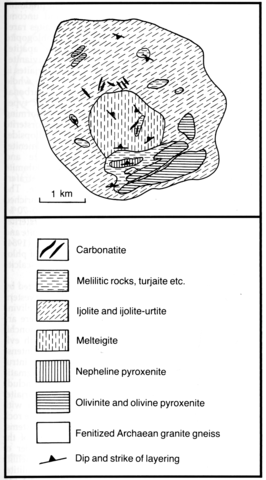stripes
Together with the Afrikanda, Ozernaya Varaka and Lesnaya Varaka complexes, Salmagorskii constitutes one of the Khabozerskaya group of intrusions, the location of which is controlled by a single fracture zone. These complexes seem to be comagmatic. Salmagorskii is almost circular in shape and has an area of about 20 km2. It has a partially zoned structure with an unusual, for the Kola-Karelia group of alkaline occurrences, combination of ultramafic and alkaline rocks. Olivinites and subordinate olivine-pyroxene rocks (wehrlites) and clinopyroxenites form steeply-dipping lens-shaped bodies in the peripheral parts of the massif and occupy about 15% of the area. These rocks are cross-cut and injected by an alkaline intrusion of melteigite and urtite which comprises the principle body of the complex. The melteigites are localized in the central area while ijolite and ijolite-urtite tend to be concentrated at the periphery. The ultramafic rocks of the southeastern part of the complex are surrounded by an aureole of essentially melilitic rocks, which include melilitolites, monticellite rocks, monticellite-melilite turjaites and turjaites, and these represent high-temperature, contact reaction rocks. Within them an association of calcium silicates and micas is found including monticellite, andradite-grossular, diopside, cancrinite and phlogopite. A dyke facies is represented by ijolite porphyries and monchiquites; carbonatites occur as rare, relatively thin veins composed of calcite and ankerite. In calcite carbonatites aegirine-diopside, wollastonite, phlogopite, chlorite and zeolites are present in variable, but subordinate, amounts. The accessory minerals include apatite, hematite, titanite and zircon. In the calcite-ankerite carbonatites calcite and ankerite account for 30 to 40% of the rock by volume and aegirine-diopside, chlorite and zeolites are also present with accessory apatite, magnetite, hematite, anatase, titanite, zircon and pyrochlore. At the contacts between the carbonatites and the alkaline, melilite and ultramafic rocks zones of phlogopite-carbonate rocks are developed.
KUKHARENKO, A.A., ORLOVA, M.P., BULAKH, A.G., BAGDASAROV, E.A., RIMSKAYA-KORSAKOVA, O.M., NEPHEDOV, E.I., IL'INSKII, G.A., SERGEEV, A.S. and ABAKUMOVA, N.B. 1965. The Caledonian complex of ultrabasic alkaline rocks and carbonatites of the Kola peninsula and north Karelia. Nedra, Moscow. 772 pp.
*KONONOVA, V.A. and SHANIN, L.L. 1971. On the possible application of nepheline for alkaline rock dating. Bulletin Volcanologique, 35: 1-14.
ORLOVA, M.P. 1959. On the genesis of turjaite of the Salmagorsky massif on the Kola peninsula. In Materials on the mineralogy of ore deposits. All-Union Scientific Research Geological Institute, New Series, 26: 10-8.

